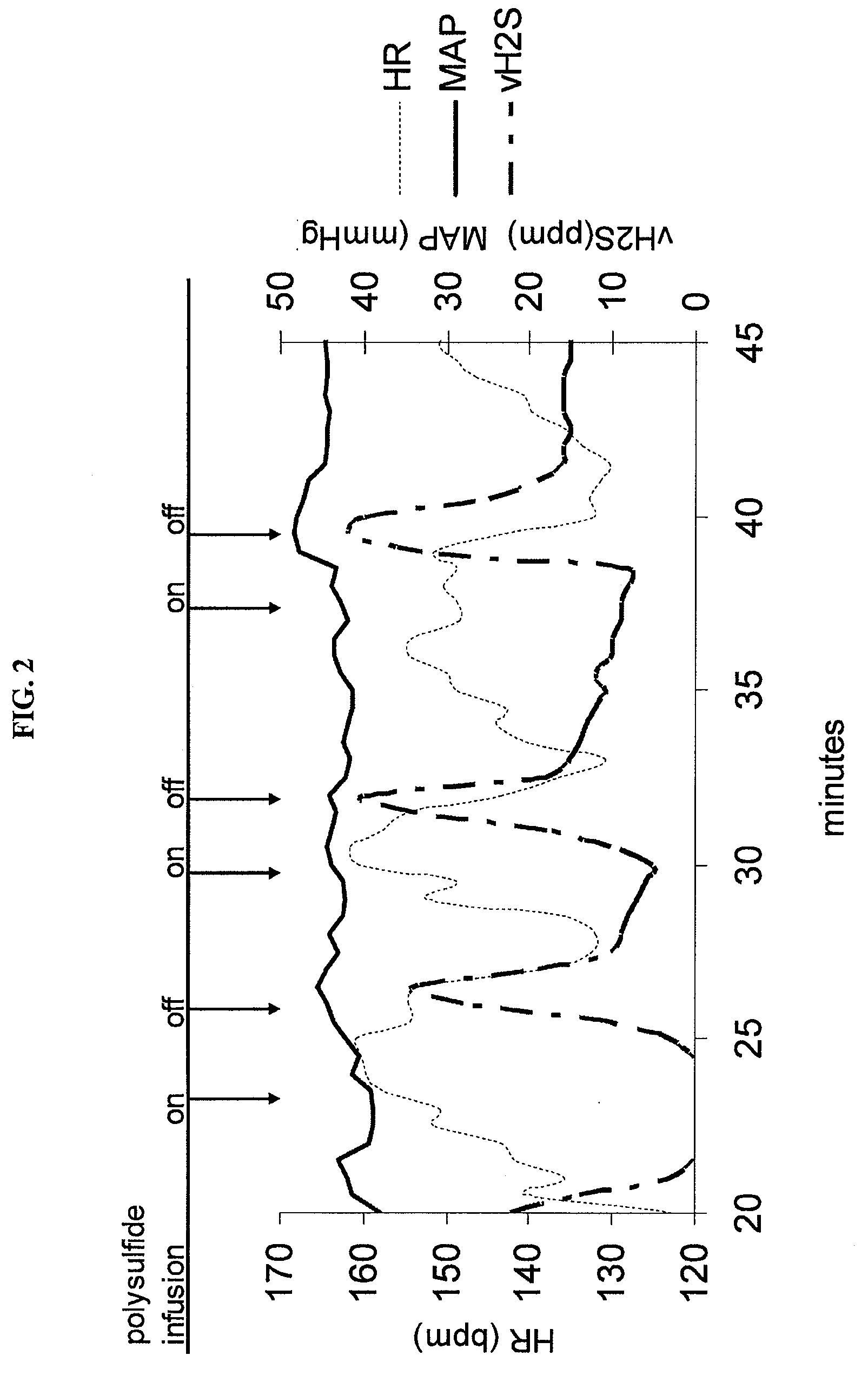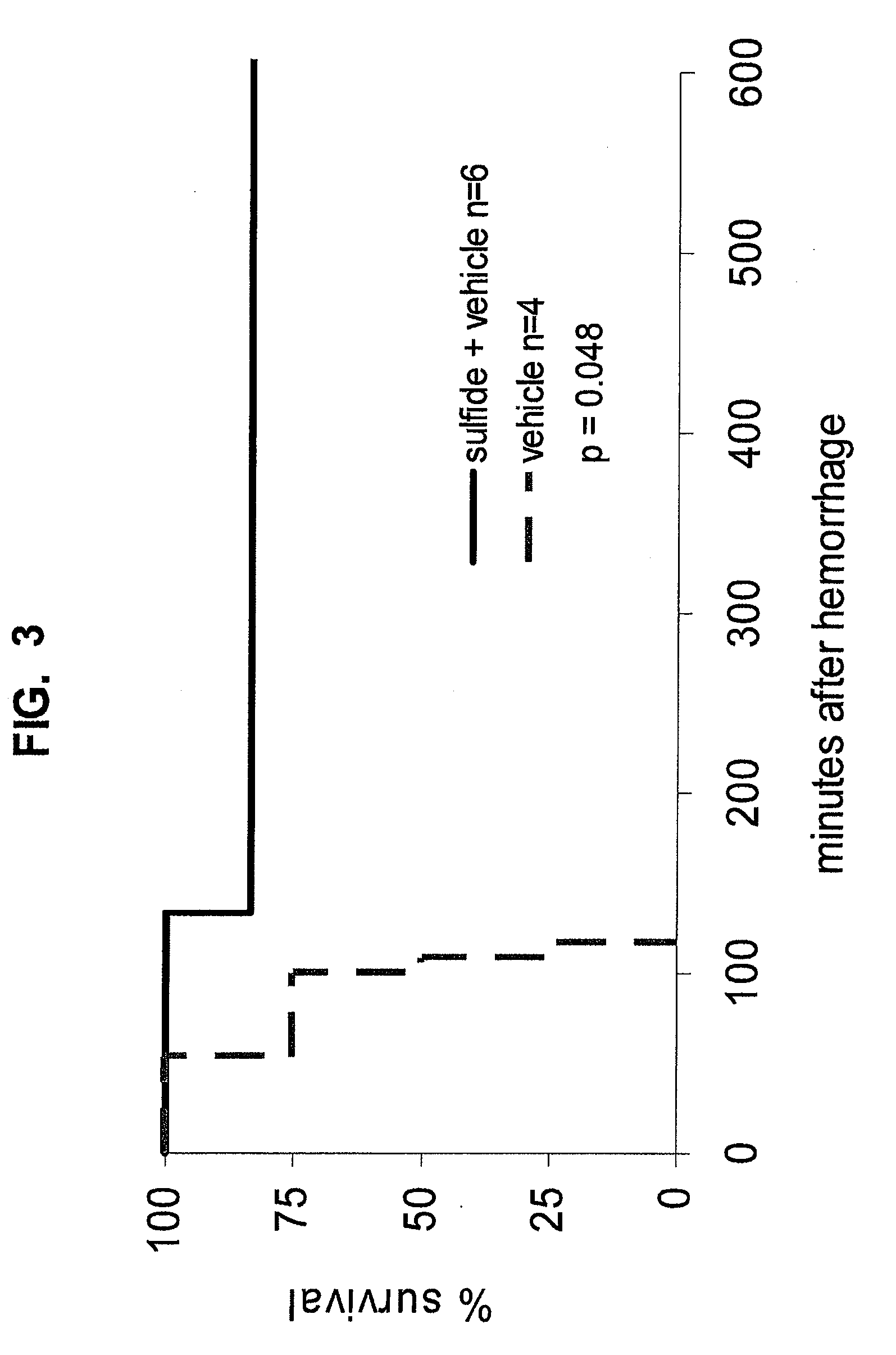Methods and compositions regarding polychalcogenide compositions
a technology of polychalcogenide and composition, applied in the field of cell biology, physiology, medicine, can solve the problems that time remains a significant factor in whether treatment will work, and achieve the effect of enhancing the survivability of biological matter
- Summary
- Abstract
- Description
- Claims
- Application Information
AI Technical Summary
Benefits of technology
Problems solved by technology
Method used
Image
Examples
example 1
Preparation of Sodium Polysulfide Oil
[0202]The following method is taken from the literature (Steudel, 2003a, b). Sodium polysulfide oil was synthesized by adding 2 parts sodium sulfide nonahydrate (Aldrich product no. 431648) with one part elemental sulfur (S8) (Fisher catalog no. S594-500; material is preferentially soluble in carbon tetrachloride); resulting solution is 800 mg / ml sodium polysulfide oil solution. One part of this solution is mixed with 9 parts 20 mM HCl; the resulting solution is 80 mg / ml sodium polysulfide oil. The resulting product was a mixture of Na2Sn compounds, wherein n ranges from 2 to 35, including both integers and non-integers. Sodium polysulfide oil comprised an average of 5.5 sulfur atoms.
example 2
Administration of Sodium Polysulfide Oil to Pigs Results in a Reduction of Tachycardia with Minimal Effect on Blood Pressure
[0203]Three separate pigs were tested with the following protocol, the results of which can be seen in FIG. 1 and FIG. 2. FIG. 1 shows the results of the entire timespan of one experiment while FIG. 2 focuses on minutes 20-45 of the same experiment.
[0204]A pig was dosed six times with a sodium polysulfide oil as prepared in Example 1 (80 mg / ml). Infusion took place through a femoral vein catheter using an infusion pump. The first dose, 60 mg / kg / hr delivered with a Harvard syringe pump, administered after 400 out of 800 ml of blood was removed (approximately 10 minutes after blood removal began), caused 27 ppm of hydrogen sulfide (H2S) to be exhaled before the infusion was stopped (total infusion time was 5 minutes). The second dose of 60 mg / kg / hr was begun approximately 5 minutes later. After one minute the pig exhaled 34 ppm H2S and the heart rate (HR) fell fr...
example 3
Administration of Sodium Polysulfide Oil Protects Against Lethal Hemorrhage
[0207]To determine whether sodium polysulfide oil could be used to reduce morbidity and / or tissue damage associated with a clinically relevant acute injury model of ischemic hypoxia, rats were treated with the sodium polysulfide oil of Example 1 during controlled lethal hemorrhage. In this study, rats treated with sodium polysulfide oil survived lethal blood loss and fully recovered.
[0208]Rats were treated with sodium polysulfide oil during controlled lethal hemorrhage (60% blood loss). After surgical implantation of catheters and recovery, blood was removed from conscious animals over 40 minutes. A sodium polysulfide oil dosage of approx. 30 mg / kg / hr was infused during the last 20 minutes of the bleed and during the first 20 minutes after the bleed had stopped. Three hours after the end of the bleed, surviving animals were given one shed-blood volume of lactated ringers solution intravenously. Most (⅝) of th...
PUM
| Property | Measurement | Unit |
|---|---|---|
| Fraction | aaaaa | aaaaa |
| Fraction | aaaaa | aaaaa |
| Pressure | aaaaa | aaaaa |
Abstract
Description
Claims
Application Information
 Login to View More
Login to View More - R&D
- Intellectual Property
- Life Sciences
- Materials
- Tech Scout
- Unparalleled Data Quality
- Higher Quality Content
- 60% Fewer Hallucinations
Browse by: Latest US Patents, China's latest patents, Technical Efficacy Thesaurus, Application Domain, Technology Topic, Popular Technical Reports.
© 2025 PatSnap. All rights reserved.Legal|Privacy policy|Modern Slavery Act Transparency Statement|Sitemap|About US| Contact US: help@patsnap.com



